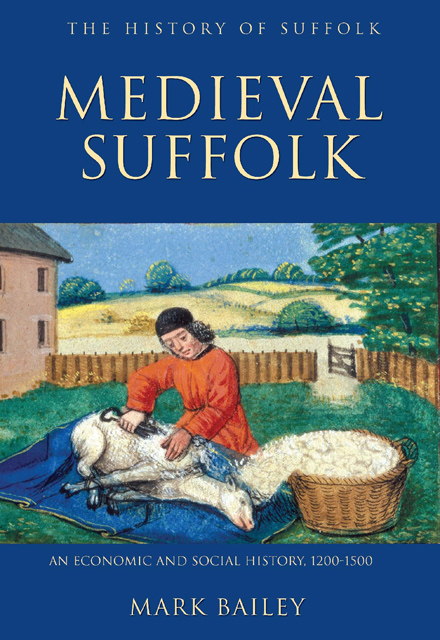Book contents
- Frontmatter
- Contents
- List of Plates
- List of Maps
- List of Tables
- Foreword
- Acknowledgements
- Note on Currency & Units of Measurement
- Abbreviations
- 1 Introduction
- 2 Landlords and their Estates, 1200–1349
- 3 Peasants and their Lifestyles, 1200–1349
- 4 The Agrarian Economy, 1200–1349
- 5 The Suffolk Landscape, 1200–1349
- 6 Towns and the Urban Environment
- 7 Commerce, Crafts and Industry
- 8 Pestilence, Rebellion and the Decline of Villeinage, 1349–1500
- 9 The Rural Economy, 1350–1500
- 10 ‘The World Turned Upside Down’: Rural Society, 1350–1500
- 11 Towns, Trade and Industry, 1350–1500
- 12 Conclusion
- Bibliography
- Index
- Frontmatter
- Contents
- List of Plates
- List of Maps
- List of Tables
- Foreword
- Acknowledgements
- Note on Currency & Units of Measurement
- Abbreviations
- 1 Introduction
- 2 Landlords and their Estates, 1200–1349
- 3 Peasants and their Lifestyles, 1200–1349
- 4 The Agrarian Economy, 1200–1349
- 5 The Suffolk Landscape, 1200–1349
- 6 Towns and the Urban Environment
- 7 Commerce, Crafts and Industry
- 8 Pestilence, Rebellion and the Decline of Villeinage, 1349–1500
- 9 The Rural Economy, 1350–1500
- 10 ‘The World Turned Upside Down’: Rural Society, 1350–1500
- 11 Towns, Trade and Industry, 1350–1500
- 12 Conclusion
- Bibliography
- Index
Summary
Medieval Suffolk possessed a highly distinctive social structure. It was a county of weak manorialism, where the average vill was split between a number of manors; the typical manor was small; and the average manorial lord directly worked his demesne land and was modestly wealthy. In c. 1300 at least 80 per cent of all tenants and tenancies were free, one of the highest proportions in England, and conversely the proportion of villeins and unfree tenancies was among the lowest. Head rents on both free and villein holdings were relatively low, and landlords adopted a permissive approach to the sale and transfer of land between peasants, both of which encouraged a thriving land market and the subdivision of landholdings. The reality of villeinage in this predominantly free region was far removed from the onerous burdens of its legal theory, or the experience of villeins in midland England. Consequently, the tight bonds which are traditionally assumed to have shackled feudal society had been significantly loosened in medieval Suffolk, where peasants possessed greater freedom of time and action. Few areas of medieval England had freer or more fragmented social structures, and the example of Suffolk confirms the correlation between such areas and those of advanced economic development.
The average size of peasant holdings had fallen during the course of the thirteenth century, and their output per acre had probably risen, due to demographic pressure and institutional permissiveness. By c. 1300 around 75 per cent of all peasant holdings comprised less than 10 acres in Suffolk, and perhaps one-half of the population were landless labourers, servants and townsfolk, which meant that many people were forced to seek alternative employment to make ends meet. The opportunities for such employment – in agricultural wage labouring, petty retailing, craft manufacture, transportation and fuel production – were greater here than in many parts of the country, because of both the degree of commercial activity and the natural diversity of the resource base. These natural resources were expertly harnessed and intensively exploited to yield a range of valuable products from marsh, heath, wood, meadow and pasture. Before the Black Death there was no such thing as wasteland in Suffolk.
- Type
- Chapter
- Information
- Medieval SuffolkAn Economic and Social History, 1200-1500, pp. 290 - 302Publisher: Boydell & BrewerPrint publication year: 2007



